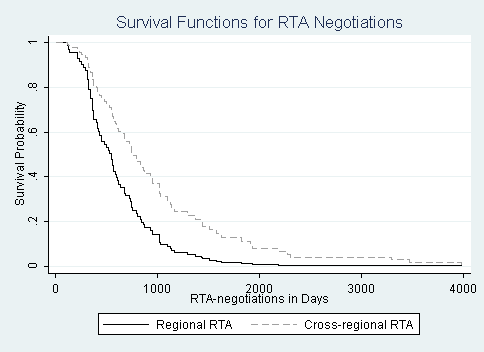There is widespread agreement among economists that trade liberalisation is best conducted at the multilateral level. Indeed, facilitating multilateral negotiations is one of the primary objectives of the World Trade Organisation (WTO), as it was with its predecessor the General Agreement on Tariffs and Trade (GATT). By way of contrast, regional trade agreements (RTAs) may create some trade, but they also have the potential to harmfully divert it.
Still, the global approach to multilateral trade liberalisation seems moribund. The Doha Round sponsored by the WTO has just ‘celebrated’ its tenth birthday, with no end in sight (see Baldwin and Evenett 2011 on this site). The duration of GATT/WTO trade liberalisation rounds – the length of time between the start of negotiations and their completion – has grown consistently with the number of participants. The 23 participants of the first (Geneva) round of GATT negotiations took only six months to conclude a deal that reduced 45,000 tariffs. But there are now over 150 members of the WTO, a number that makes negotiations considerably more difficult. Table 1 shows the facts for all the trade rounds.
Table 1. Tariff cuts in the GATT rounds, 1947 to 1994
| |
Start |
Length
(months)
|
Average tariff
cut %
|
Tariff per
month (a) |
Number of
members (b) |
Number of
DCs (c) |
| Geneva I |
1947 |
8 |
26.0 |
39.0 |
19 |
7 |
| Annecy |
1949 |
8 |
3.0 |
4.5 |
20 |
8 |
| Torquay |
1950 |
8 |
4.0 |
6.0 |
33 |
13 |
| Geneva II |
1955 |
16 |
3.0 |
2.3 |
35 |
14 |
| Dillon |
1960 |
10 |
4.0 |
4.8 |
40 |
19 |
| Kennedy |
1963 |
42 |
37.0 |
10.6 |
74 |
44 |
| Tokyo |
1974 |
74 |
33.0 |
5.4 |
84 |
51 |
| Uruguay |
1986 |
91 |
38.0 |
5.0 |
125 |
88 |
Source: Martin and Messerlin (2007)
Note: Average cuts in bound tariffs. Import weighted tariff cuts of industrial countries for industrial products (petroleum excluded). The five first figures refer to the average tariff cuts of the US only. (a) Average tariff cut per year of negotiations. (b) GATT members at the end year of the negotiations (source: WTO website). (c) G-77 membership is taken as a proxy for defining ‘developing’ GATT members.
New research on duration of regional trade agreement talks
As it would be problematic to generalise from the small number of observations on global rounds of trade talks, our paper studies the factors that determine the length of trade negotiations for regional trade agreements. These are numerous and similar in nature to their GATT/WTO analogues (Moser and Rose 2012).
Data and methodology
It is not straightforward to measure the length of negotiations. We build on the exact announcement dates of the start and conclusion of regional trade agreements as identified through a full-text search in LexisNexis (see Moser and Rose 2011 for more details on data set). More precisely, we define the duration of regional trade negotiations as the elapsed time from the day when it was officially announced that negotiations on a trade agreement will commence at some future date to the day that agreement was eventually reached – such announcements are typically made by important policymakers of the affected countries. Our data sample covers 88 regional trade agreements from 1988 to 2009. On average, trade negotiations take 28 months, but there is large variation in the length of negotiations.
We estimate a standard Cox proportional hazards model that links the duration of RTA trade negotiations to a number of economic determinants (Cox 1972). In particular, the model asks: what effect does the complexity of trade negotiations have on the duration of those negotiations?
More is not merrier
We find that negotiations take significantly longer when they involve more countries, especially if the countries are spread across different regions. The latter finding is also reflected in the Figure 1. It shows the survival functions for Regional and Cross-regional RTAs, with other control variables held at their average values.
Figure 1. Survival functions for RTA negotiations
We also find somehow weaker results for two other economic variables: regional trade agreement partners that are more open to trade and richer tend to conclude their agreements more quickly.
Equally interesting, we also found many negative results. Among those candidates for which we could not identify a measurable effect on the length of negotiations are export importance or income divergence. Moelders (2012) has recently confirmed that bilateral trade agreements tend to be hammered out more quickly. Beyond that, he shows that political factors seem to matter as well.
Conclusions
These results lead us to be pessimistic about the prospects for future global trade talks. The membership of the WTO continues to grow as the few remaining outsider countries (such as Russia) join. As the number of participants and the diversity of their preferences grow, it becomes increasingly difficult to imagine a successful conclusion to the Doha Round, let alone future liberalisation rounds engineered under the auspices of the WTO. While multilateral liberalisation has many advantages over regional trade liberalisation, feasibility does not appear to be among them.
References
Baldwin, R and SJ Evenett (eds.) (2011), Next Steps: Getting Past the Doha Round Crisis, A VoxEU.org Publication, 28 May.
Cox, DR (1972), “Regression Models and Life-tables”, Journal of the Royal Statistical Society, Series B, 34:187-220.
Martin, Will and Patrick Messerlin (2007), “Why is it so Difficult? Trade Liberalization Under the Doha Agenda”, Oxford Review of Economic Policy, 23(3):347-366.
Moelders, Florian (2012), “The Road to Trade Liberalization is Paved with Good Intentions: A Survival Analysis of Trade Negotiations”, DIW Berlin, unpublished manuscript.
Moser, Christoph and Andrew Rose (2011), “Who Benefits from Regional Trade Agreements? The View from the Stock Market”, CEPR Discussion Paper No. 8566.
Moser, Christoph and Andrew Rose (2012), “Why Do Trade Negotations Take So Long?”, KOF Working Paper No. 295 and CEPR Discussion Paper No. 8993.



